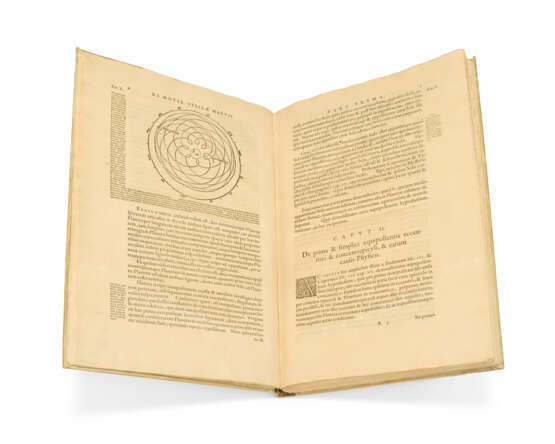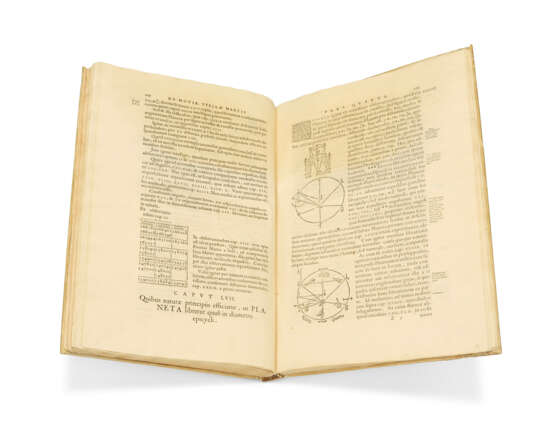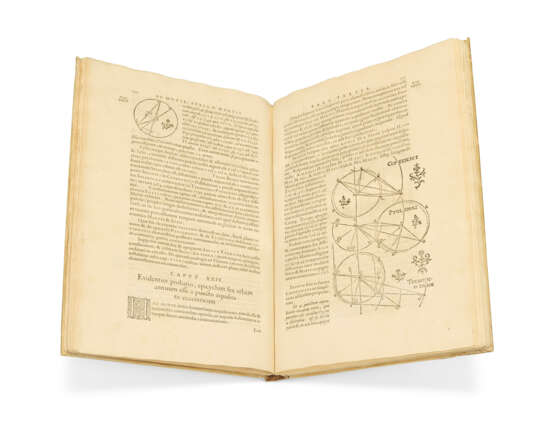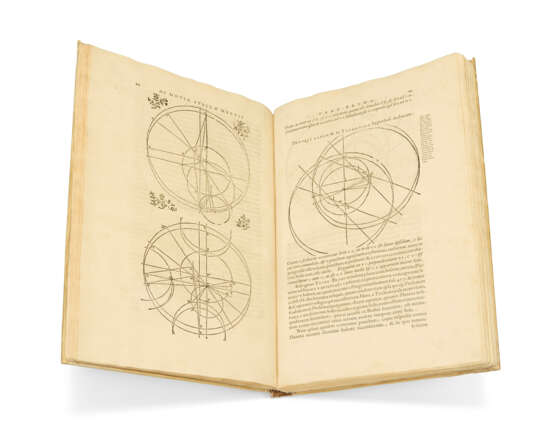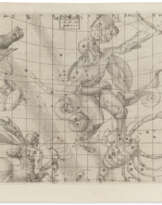ID 1360816
Лот 100 | Astronomia nova
Оценочная стоимость
$ 120 000 – 180 000
First edition of Kepler's masterpiece—the cornerstone of modern astronomy, containing the first presentation of the first two laws of planetary motion. While Copernicus is credited as the originator of the heliocentric model of our solar system, it is Kepler who truly delivered astronomy (and heliocentrism) out of the realm of abstract mathematical speculation and into the concrete world of physics and natural philosophy. It is a work of not only great importance but great charm and inventiveness, which "signifies the beginning of the end for a millennia-old tradition of mathematical astronomy" (Voelkel) and directly presages the discoveries of Newton in the next generation.
Following the publication of his ingenious Copernican treatise, the Mysterium cosmographium, Kepler came to the attention of Tycho Brahe, who had been collecting decades of astronomical data at his massive island observatory at Uraniborg. After several years of correspondence, Tycho invited Kepler to his new observatory at Benátky Castle in Prague as an assistant. Although hoping to get access to Tycho's meticulous observational data, Kepler was assigned to work on the theory of Mars; Tycho was protective of his intellectual property. But in his study of the orbit of the red planet, Kepler found the key to his new astronomy, writing in a 1602 letter "in short, I have beheld the sun in the theory of Mars as though in a mirror, in that I see how and to what extent it affects all planets. I take from Mars the example for treating the others, and thus I hope presently for all the best for every part of astronomy."
Kepler's first two laws, that the orbit of a planet is an ellipse with the sun at one of its foci, and that a line segment between a planet and the sun sweeps out equal areas during equal intervals of time (that is, that planets move faster when they are closer to the sun), were made particularly apparent in his study of Mars because Mars's orbit is more eccentric than most of the other planets in the solar system. These revolutionary conclusions first appeared in the aptly titled present work, Astronomia nova. In its preface, Kepler frames his discoveries as a victory over Mars, who had so long defied "the stratagems of astronomers." Mars's behavior was inscrutable to observers working with an understanding of circular orbits; thus, Kepler's "new astronomy" was necessary to understand it—and the rest of the solar system.
While the style of the Astronomia nova has been characterized, most influentially by Arthur Koestler in The Sleepwalkers, as rather unacademic and haphazard, modern scholars have refuted this idea. "Because Kepler knew the resistance his reformation of astronomical theory would face, he worked hard to demonstrate the necessity of each step" (Voelkel). His radical combination of mathematics and physical causes necessitated a careful didactic program, designed to take readers on the same journey of trial and error that led Kepler to his groundbreaking conclusions (and thus also head off potential refutations). This attention to his reader is obvious even in the typographic plan of the printed book itself. "He simplified the reading of the book for those not interested in in geometrical demonstrations by having the demonstrations set in italic type, leaving those parts where physics was mixed in with geometry in plain type" (Voelkel), with a detailed folding synoptic table of contents and summaries meant for those interested in the physical sciences, allowing scholars with differing expertise to navigate the book with ease.
The work was finished in 1605, after Tycho's untimely death had catapulted Kepler into the role of Imperial Mathematician, but its publication was delayed. This was partially the result of an ongoing dispute with Tycho Brahe's heirs, who also had a vested interest in his data. In 1607 Kepler had the woodblocks cut in Prague, and in 1608 he sent the text to be printed by E. Vögelin in Heidelberg. The absence of an imprint is due to the fact that the edition was not intended for commerce: the Emperor held the rights to its distribution, since Kepler had written it as court mathematician and it had been printed at imperial expense. Although the size of the print run is not recorded, Kepler later stated that only "a few copies" had been printed. Caspar 31; Dibner 9; Grolier/Horblit 57; Norman 1206; PMM 112. See also James Voelkel, The Composition of the Astronomia nova (2001).
Folio (384 x 248mm). Dedication to Emperor Rudolph II, folding letterpress synoptic table, approximately 300 woodcut text diagrams (many repeated), woodcut initials, head- and tailpieces. First three and final blank leaves removed. Without the engraved portrait inserted in a few copies. (Title with a very short marginal tear and re-sized, variable staining, table browned, final gathering repaired at gutter, occasional minor worming.) Modern vellum, preserving older red morocco gilt spine label (extremities lightly rubbed); slipcase. Provenance: Giancarlo Beltrame (sale, Christie’s 13 July 2016, lot 66) – Owen Gingerich (bookplate).
| Автор: | Иоганн Кеплер (1571 - 1630) |
|---|---|
| Место происхождения: | Германия |
| Автор: | Иоганн Кеплер (1571 - 1630) |
|---|---|
| Место происхождения: | Германия |
| Адрес торгов |
CHRISTIE'S 20 Rockefeller Plaza 10020 New York США | ||||||||||||||
|---|---|---|---|---|---|---|---|---|---|---|---|---|---|---|---|
| Предосмотр |
| ||||||||||||||
| Телефон | +1 212 636 2000 | ||||||||||||||
| Факс | +1 212 636 4930 | ||||||||||||||
| Условия использования | Условия использования | ||||||||||||||
| Транспортировка |
Почтовая служба Курьерская служба Самовывоз | ||||||||||||||
| Способы оплаты |
Банковский перевод | ||||||||||||||
| Часы работы | Часы работы
|
